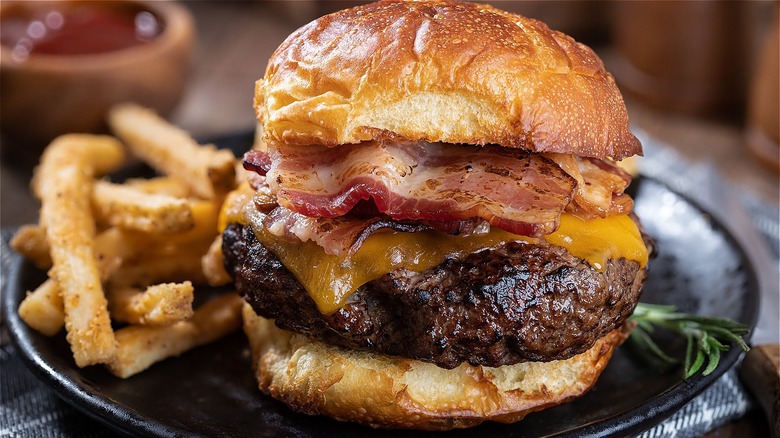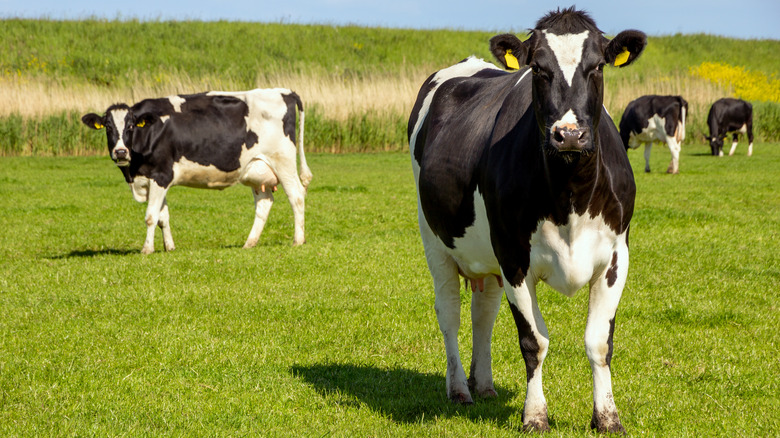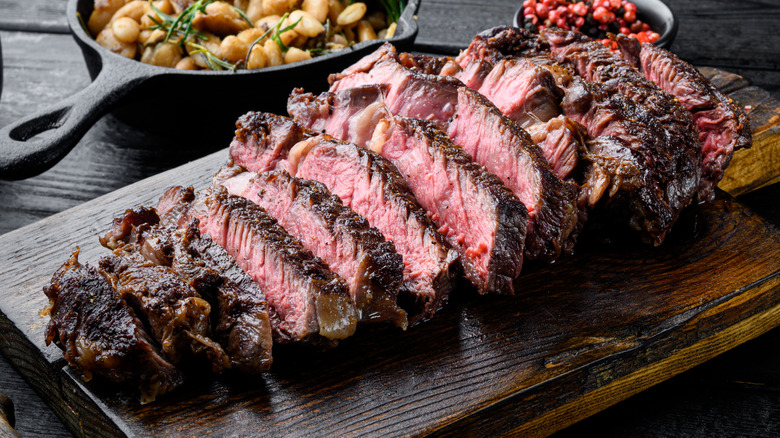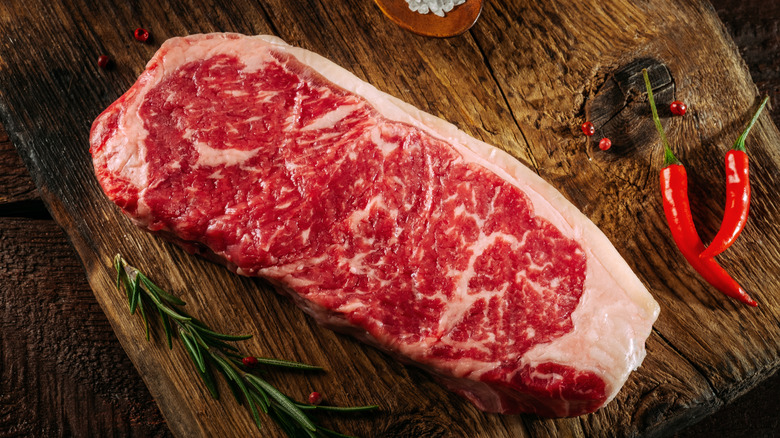Why Holstein Beef Could Be The Next Best Alternative To Angus
Two of the most popular breeds of cattle are Holstein cows, which are the black and white dairy cows you see dotting American farm fields, and Angus cows, black or red cows that are bred for their beef. Beef cows far outnumber dairy cows in the United States; in 2022 there were 30.1 million beef cows compared to just 9.4 million dairy cows, with 779.1 million pounds of beef exported in the first half of 2023, mostly to Asian countries like Japan and China.
Despite the clear preference for beef cows, the amount of beef that comes from dairy cows in the United States is not insignificant. In 2019 around 21% of beef came from a dairy cow, out of 27.3 billion pounds. The quality of dairy cow beef is often misconceived as being of poorer quality and therefore only good for ground meat, but dairy cows are also used for higher-end cuts. In fact, beef from Holstein cows might be a good alternative to Angus beef.
Holstein cows aren't usually known for their beef
Holsteins (Bos taurus taurus) are prolific dairy cows that can be milked three times a day, and in 2021 U.S. Holstein herds produced 28,047 pounds of milk and 1,121 pounds of butterfat. Because of this reputation as superior dairy cows, many people don't often think of Holstein for their beef, but both male and female Holsteins make for great meat as well.
Older Holstein heifers are put out to pasture for up to a year after their last milking to give them time to graze on grasses and gain fat and muscle before being sent to slaughter. This retired dairy beef has been compared to wagyu by some chefs and the older the cow, the better the meat. As for male Holsteins, there isn't much use for them on a dairy farm so they typically either go to veal production or are culled, but some farmers choose to raise their Holstein steers for beef production.
Holstein beef is a flavorful and juicy alternative to Angus
Angus cows grow faster and on less feed than a Holstein, so they tend to be younger when sent to slaughter, usually well before the time they reach 3 years old when their meat is still tender. Dairy cows, however, can be up to 6 years old before heading to slaughter, which isn't necessarily a bad thing — just because a Holstein cow is older doesn't mean that the meat is less flavorful than a youthful Angus. In fact, older cows tend to be more flavorful than younger cows, with richer flavor profiles.
Beef from a Holstein is super tender and flavorful, owing to its marbling. When looking at a Holstein steak, the muscle is dotted with many fine lines of fat that will render out and make the meat super tender. A Holstein also has less connective tissue, which can make for tough beef, than Angus.
If you're looking to choose between Angus and Holstein for the best cuts of steak, it all comes down to your preferences. Angus has been described as inherently beefy, which some prefer. Holsteins tend to lean more creamy and buttery in flavor due to the milk fat content, which is higher than in other cow breeds. Holstein beef also tends to be cheaper than Angus because the meat is essentially a byproduct of dairy production.
Lots of marbling makes Holstein beef a good candidate for searing
To take advantage of the buttery flavor and high marbling in Holstein, sear your steak in a hot pan or over the grill, or cook it low and slow in the oven until it's medium-rare, then slice and serve. Before cooking, however, let your steaks come to room temperature for about a half hour. Putting cold meat in a hot pan can lead to uneven cooking.
Be sure to not overcook your Holstein steak or you'll waste all that flavorful marbling. A good medium rare steak is between 130 and 135 degrees Fahrenheit, but pull it about 5 degrees shy of your ideal temperature. Carryover cooking will take the steak up to temperature as it rests, anywhere from 10 to 15 minutes. If you're cutting the steak for presentation, cut against the grain so the meat isn't chewy, and you'll have happy dinner guests.
Finding Holstein beef requires specialty butchers or online shops
If you're looking to try a bit of Holstein beef for your next steak night, you're probably better off taking a trip to the butcher instead of the meat counter at your local grocery store since the majority of beef you'll find there is Angus or another common beef breed. If a local specialty butcher isn't an option where you live, you'll need to depend on online shops. To ensure you're getting the best quality of Holstein beef, speak to your butcher or online shop about where the cow came from, and ask about USDA steak grades.
Flannery Beef deals only in Holstein beef and dry ages its cuts from 30 to 90 days in two-week intervals. A dry-aged 16-ounce hanger steak will run you $30, while a 12-ounce 90-day New York steak costs $75. Calhoun Livestock, based out of Virginia, supplies grass-finished Holstein beef; a brisket starts at $31.37, and a box of beef at $249. Hansen's Dairy in Iowa can ship its Wagyu-Holstein beef to you – its 12-ounce New York Strip is $30.




